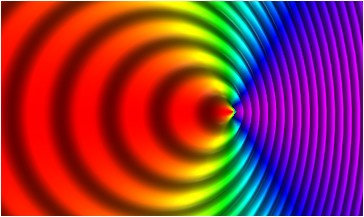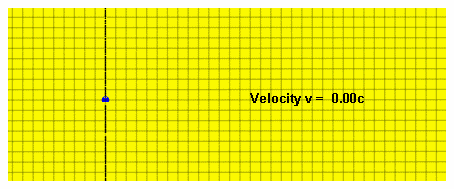Lights at Light's Speed
Measuring speed is easy: Take your trusted measuring stick and stop the time it takes to cross it. So tell me, how fast is that star over there? Okay, how about a speeding car?
Astronomers and radar-guns share some kind of magic that lets them look at something and instantly know how fast it's going. Though different in detail, the effect both use is the exact same. But there is a lot more to it than just measuring speed.
Speeding Stars
Let's look at a light bulb. A perfectly round one. With a battery inside. That will be our star-standin, because throwing light bulbs is much easier than throwing stars. And let's use a yellow light bulb, simply because white is actually a mixture of many colors, whereas yellow is a single color. That will be important later.
Now throw the bulb. Faster. More faster. Just a bit closer to the speed of light would be great! Don't worry, there will be only slight relativistic effects involved. For the most part, all we need to consider is that light, no matter what, moves at the speed of light.
For our purposes, every ray of light behaves just like a stream of water. The bulb sends out rays in every direction, which would look like a badly leaking rain cloud.
Say a rain cloud stormed at you at roughly the speed of falling raindrops. It spurts out raindrops to all sides, but all these raindrops get an extra velocity added to them. So raindrops that the cloud spurts out sideways now fly towards you at an angle. Raindrops spurted out backwards are now very slow, while raindrops spurted out forward are much faster. And if you don't know this, you point the umbrella in the wrong direction. Raindrops coming from a moving cloud will always hit you at an angle, not straight down. It's the same for moving light bulbs.
Raindrops don't have a certain speed imposed onto them. Light does. So to get from Raindrops to rays of light, we need to squeeze and stretch them, until their speed matches that of light. Since light rays sent backwards would be too slow, they need to be stretched while those sent forward need to be squeezed. Remember, rays sent to the side actually move a bit forward now, so they will be squeezed a bit as well.
Squeezing and stretching actually happens all the time with waves. It's called the Doppler effect. You can observe it by moving something through water. The waves breaking at it's brim will travel equally fast in all directions, so waves behind the object will be stretched while those in front will be squeezed.

I promised a bit of relativity. Releasing light is just another process. So if time slows down, this process slows down and not as much light is released. The overall brightness of the bulb gets a bit dimmed. That's it, no more relativity!
Outsiders
So far, all we talked about is how the light coming off the bulb's surface will be transformed when the bulb is very fast. It's time to talk about how it looks.
First, the colors: When light rays get squeezed, their wavelength changes. Wavelength is equal to color. That means the rays sent forward will transform from yellow to green, blue and ultimately violet. Those sent directly forward are squeezed the most, while those that seem to go sideways from the outside (which are those the bulb released slightly backwards) will still look yellow. Rays sent backwards on the other hand will be stretched, turning yellow into red and close to infrared. Our once boring yellow light is now, depending on how you look at it, a rainbow of all colors.

And that simple effect allows us to measure the speed of stars. We know very well what colors a star shows and by measuring how much reder or bluer those colors are, we can determine the stars' speed.
But, there's more! As I mentioned rays sent sideways will be bent forward. Say we painted some black markings on the bulb (black is the absence of light, so it always has the same "color"), those would now look squeezed to anybody in front of the bulb, since he will see those from the side of the bulb as well. Anybody looking at the bulb from behind will see our markings stretched, since the rays backwards are bent sideways.
Staring down the bulb head on, you see more surface. That also means there is more energy released forward, since more surface releases more energy. But that's not all: The energy of light is higher the lower it's wavelength. Since all rays released forward are squeezed, they have a lower wavelength and more energy. A speeding light bulb will release most of it's energy forwards.

Speeding Lights vs. Speeding Cars
Cars and stars are slightly different. Stars glow, cars don't. Stars have a fixed range of colors, cars can be colored very differently. But they aren't as far away, so we can just repaint them with a known color.
A radar-gun is essentially a light source of a well defined color. It's just a very long wavelength color and our eyes can't see that anymore, similar to how your ears can't hear a dog whistle. That color is reflected by a car and thereby the car "shines" that color. When the car is moving, the color shifts again. By detecting that shift, a radar-gun can measure the speed of a car without touching it, without any measuring sticks or stopwatches.